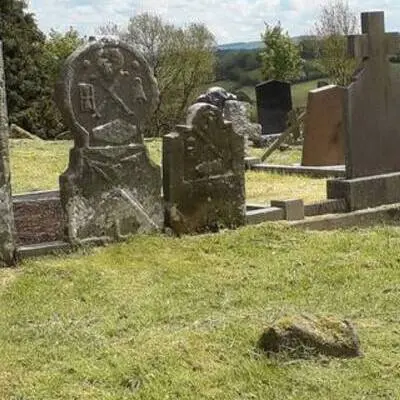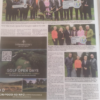Drumgoon Hill Old Graveyard is an ancient burial site and church from before 650A.D, which was established on an even older ringfort and residence of a prominent chieftain. This church & burial ground is said to be started by St. Patrick himself, and is located only 4.5 kilometres south east of Cootehill. Visit this open outdoor Museum of heritage, culture, history, ecology and geology with its majestic 360° views of the countryside, enhanced by the 25X100 Viewfinder binoculars installed on the site.
A short history of Drumgoon Hill
The ringfort on the Drumgoon hill in question, was originally named ‘Droim Dhuin’, meaning ‘Ridge of the Fort’ in gaelic. The parish of Drumgoon, outside of Cootehill, is named hereafter.
The gaelic word dún, would have only been used to signify the ‘Residence of a Chieftain of Prominence’, which tells us that a prominent Celtic leader established his ringfort here and called it home. As the river was the main mode of transport at the time, the towering hill was chosen as the perfect natural fortress to guard the River Annalee located directly below. Once inhabited, the Celts of Droim Dhuin spread to other hills in the region and set up ringforts there as well. 7 of these are viewable from Drumgoon Hill.
An analysis of a sample of charcoal and slag discovered in 2017, indicates site occupation with Iron Smelting dating back to before 650AD. There is also evidence of a well and a souterrain or underground tunnel, which could have been used to store food in the summer and also for allowing an escape from possible enemies.
Noted as a place of worship long before the Pre-Christian era, tradition says that St Patrick himself founded a Church here, making it the first Christian church in the parish. The Annals of Ulster and O’ Connell’s History of Kilmore records that St Patrick visited Drumgoon, and we know that the church and graveyard was attributed to St Patrick. As the ringfort was already an important place of pre-christian worship and society, it would have made sense to spread the christian message from here.
After uninterrupted use the church was closed to Catholic worship in 1612 when it became the first protestant place of worship in Drumgoon. The graveyard has people of three different denominations interred in it; Church of Ireland, Presbyterian and Roman Catholic. The earliest known burials are from the eighteenth century and the burial ground also holds a famine plot, which was recognised by a sculpture in 2018. In 1954 Cavan County Council closed the graveyard by order. However, burials continue to the present day – the latest burial taking place in 2019. The right to be buried here though, is reserved exclusively for people related to those interred in the family plots.
Maintenance work and the recording of unmarked graves
The Ringfort of Drumgoon hill retains much of its original features despite dating back to the iron age, due to being undisturbed and wild, bar human burials and grass maintenance. A concern was raised in 2016 around the graveyard’s upkeep and development and a voluntary committee: ‘Drumgoon Hill Graveyard Maintenance & Support Group’, was formed to research, promote, develop and maintain the hill, with funding support from Cavan Heritage, Cavan County Council, Peace 1V and National heritage. Great results have ensued from this immense and still ongoing project and a wealth of information and insight into our ancestors’ way of life and culture have been uncovered.
Drumgoon Hill Graveyard Maintenance & Support Group through their efforts, has also made Drumgoon Hill Graveyard the first medieval graveyard nationally to record and recognize unmarked graves. A practice that is now being developed nationally. They have created unique and helpful signage boards identifying all persons buried in unmarked graves, from available Church records.
These boards are available on site and can help locate the resting place of loved ones and relatives, especially sought out by Diaspora. This headstone recording information is also freely available on www.historicgraves.ie
The thriving ecology of the Hill
The Hill with its grassland and hedgerows, contains a rich natural heritage and major natural habitats. Within these there are also some microhabitats, such as the earth bank and the stone work (grave markers). The managed graveyard has become a refuge for fungi, plants and insects that are squeezed out by modern farm grassland management. With careful ecological maintenance very old seedlings have been allowed to germinate to create a unique flora and fauna to the county, indeed country
Several rare species have been identified here of the solitary bee family – the Ashy Mining Bees for instance, which is a threatened species. This is such a rare find, it has been recorded in the Biodiversity data Centre Waterford.
Information kindly provided by Drumgoon Hill Graveyard Maintenance & Support Group member Roseabby McCluskey.
Facebook page: https://www.facebook.com/Drumgoon-Hill-Old-Graveyard-1648727305436507/





